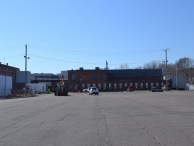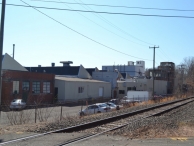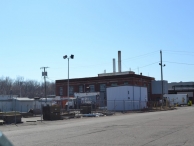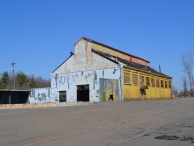Mill Record Rocky Hill
RETURN TO ‘FIND MILLS’Disclaimer: Content for these properties was compiled in 2014-2017 from a variety of sources and is subject to change. Updates are occasionally made under Property Information, however the Connecticut Trust for Historic Preservation (dba Preservation Connecticut) makes no representation or warranty that the information is complete or up-to-date.
- Complex Name (Common)
- Hartford Rayon Corp.
- Complex Name (Historic)
-
- Hartford Rayon Corp.
- Address or Location
- 60 Belamose Avenue, Rocky Hill
- County
- Hartford
- Historic Designation
- Associated Mill Community
- n/a
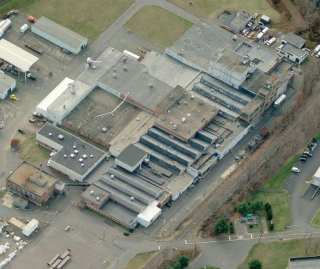
- Historic Information
Companies Associated w/Complex
- Belamose Corp. 1923-1935
- Hartford Electric Steel Corp. 1917-ca. 1920
- Hartford Fibres Co. 1959-ca. 1965
- Hartford Rayon Corp. 1935-1959
- Pratt & Whitney Aircraft Co. Div., United Aircraft Corp. 1965-1975
- Pratt & Whitney Aircraft Co. Div., United Technologies Corp. 1975-1997
Use (Historic)
Largest Documented Workforce
550 (1925).
Historic Narrative
The Hartford Rayon Corporation was originally organized as the Belamose Corporation in New York, New York in 1923. The company manufactured artificial fibers – including synthetic silk, wool, cotton, straw, horsehair, etc. –and was backed by a mix of American and Belgian financial interests. The firm was led by Theophile Guerin, a Belgian industrialist with numerous connections to textile plants in Woonsocket, Rhode Island, as president; Edmund E. Hills of Providence, Rhode Island as secretary and treasurer; and Frederick A. Hills of Hartford, Connecticut as assistant secretary and treasurer. Shortly after its establishment, the Belamose Corporation acquired a property in Rocky Hill, Connecticut that had formerly been occupied by the Hartford Electric Steel Company, a short-lived firm that manufactured steel castings during the First World War. The Belamose Corporation erected a massive new manufacturing plant on the former Hartford Electric Steel Company property in 1924, and by 1925 employed roughly 550 hands, about 300 of them being women. In April 1935, the name of the Belamose Corporation was changed to the Hartford Rayon Corporation, this in an effort to better illustrate the focus of the firm’s business. A year later, the company was reorganized by a new management team led by Bernard R. Armour of Englewood, New Jersey, president of the Heyden Chemical Company of New York, New York. The Rocky Hill plant was modernized and new more efficient practices were enacted during the late 1930s and early 1940s, these aiding in efforts to overcome the poor financial performance that had plagued the company throughout the early and mid-1930s. The company made significant contributions to the American military effort during the Second World War, as production largely focused on the manufacture of rayon parachute material. Majority control of the Hartford Rayon Corporation was acquired by the Bigelow-Sanford Carpet Company following Bernard Armour’s death in December 1949. Originally established in 1901 as a merger between the Enfield, Connecticut-based Hartford Carpet Company and New York, New York-based E.S. Higgens and Company, the Bigelow-Sanford Carpet Company had since evolved into a massive Delaware-based holding company. The firm’s interest in the Hartford Rayon Corporation was largely driven by the increasing use of synthetic materials in carpet production and although work at the Rocky Hill plant had been stopped in early 1950 due to financial problems at Hartford Rayon, production lines were modernized and work was soon resumed as the firm was established as an independent division of Bigelow-Sanford. New developments soon followed as the company announced its new ‘Kolorbon’ process, which allowed for greatly increased color options for rayon carpets, in 1956, and its move into the fields of drapery and upholstery fabric production in 1957. In 1959, Bigelow-Sanford changed the name of the Hartford Rayon Corporation to the Hartford Fibres Company. Then, in 1961, Bigelow-Sanford sold off the Hartford Fibres Company division to the American Enka Company, an Asheville, North Carolina-based manufacturer and the world’s largest producer of rayon. The Rocky Hill plant remained busy with activity into the mid-1960s, however, American Enka eventually closed the factory in 1965. After the departure of the Hartford Fibres Company, the Rocky Hill plant was occupied by the Pratt and Whitney Aircraft Company division of the United Aircraft Corporation. The Pratt and Whitney Aircraft Company manufactured composite aircraft parts at the factory and occupied the property into the mid-1990s. The firm employed 450 workers in 1996, the year plans to close the plant were announced. The majority of these employees were transferred to Pratt and Whitney’s Middletown branch and operations in Rocky Hill ended in 1997.
- Architectural Information
Number of Existing Buildings
Roughly twenty (20) primary blocks.
Dates of Construction
1917, 1924, ca. 1930, 1939, 1947, ca. 1970, ca. 1980.
Architect
n/a
Builder
n/a
Building Type
Architectural Description
The former Hartford Rayon Corporation plant consists of a sprawling complex comprised of roughly twenty adjoining and freestanding primary blocks located at the eastern terminus of Belamose Avenue, roughly 700’ east of Belamose Avenue’s intersection with Dividend and Old Forge Roads. The oldest portion of the plant was erected ca. 1917 for the Hartford Electric Steel Corporation and stands approximately 585’ northeast of manufacturing buildings built by the Hartford Rayon Corporation. The 1917 structure is a two-story, 86’ x 155’ reinforced concrete foundry with a mix of red brick apron walls and corrugated metal siding, large rectangular window openings with multipane metal sash, and a front-facing gable roof with a full-length, gabled clerestory monitor. There are large bay doors on the block’s south (façade) elevation and a one-story, 32’ x 75’ ell adjoining its west (side) elevation. The primary manufacturing plant erected for the Hartford Rayon Corporation was built in 1924. This consists of a one- and two-story, 140’ x 550’ red brick block with a concrete foundation, rectangular window openings with concrete sills and multipane metal windows with pivot-style sash, a molded concrete cornice that extends across the window openings forming the lintels on the west (and presumably east, although this side of the building has been obscured by later additions) elevation, a tall red brick parapet with concrete coping, and a flat roof with tall, full-width sawtooth monitors. The factory’s powerhouse stands 80’ northeast of the 1924 plant. This was erected in 1924 and is a one-and-a-half-story, 68’ x 98’ red brick block with a concrete foundation, rectangular window openings with concrete sills and multipane metal windows with pivot-style sash, two molded concrete cornices, a tall red brick parapet with concrete coping, and a flat roof. A particularly notable addition to the 1924 facility was built at the southwest corner of the plant ca. 1930. This consists of a two- three-, and four-story, 24’ x 112’ reinforced concrete block with red brick apron walls, large rectangular window openings with multipane metal sash, and flat roofs. The building was used for recovering and drying salt associated with the processes of dyeing fabric and stands adjacent to the factory’s dipping room and laboratory. Significant additions to the plant were erected adjoining the east side of the 1924 building in 1947. These housed a variety of operations and included a drying room, conditioning room, wash room, and machine shop. The additions stand one-story tall and have a combined footprint of roughly 228’ x 445’. Numerous freestanding accessory blocks built during the 1970s and 1980s are located east of the manufacturing plant. These are largely of metal-frame construction and have either flat or gabled roofs.
Exterior Material(s)
Structural System(s)
Roof Form
Roof Material
Power Source
Condition
Fair
Condition Notes
The plant is in fair condition. The facility has been significantly expanded over time and the original details of some blocks have been obscured, however, over, the various blocks appear to be well maintained and structurally sound.
- Property Information
-
Specific Location
One 54.6-acre parcel (60 Belamose Avenue) located at the eastern terminus of Belamose Avenue, roughly 700’ east of Belamose Avenue’s intersection with Dividend and Old Forge Roads.
Adjacent To
Exterior Visible from Public Road?
Yes
Parcel ID / Assessor Record Link
- 18/088 / Link →
Acreage
54.6
Use (Present)
- Sources
-
Form Completed By
Lucas A. Karmazinas
Date
3/09/2016
Bibliography
- List of Connecticut Manufacturers, 1922, 1924, 1930, 1932.
- Directory of Connecticut State Manufacturers, 1936, 1939.
- Industrial Directory of Connecticut, 1947.
- Register of War Production Facilities in Connecticut, 1951.
- Map of Hartford County, H & C.T. Smith, 1855.
- Atlas of Hartford County, Beers, Baker & Tilden, 1869.
- Sanborn Map Company, 1950.
- Aerial Survey of Connecticut, 1934, 1951, 1965, 1970, 1985.
- Hartford City Directories, Various editions.
- The Hartford Courant, 1923, 1924, 1935, 1936, 1939, 1996.
- New York Times, 1949, 1950, 1952, 1956, 1957, 1959.
- Representative View(s)Click on image to view full file

